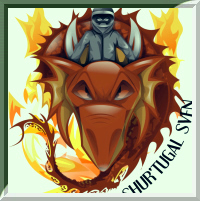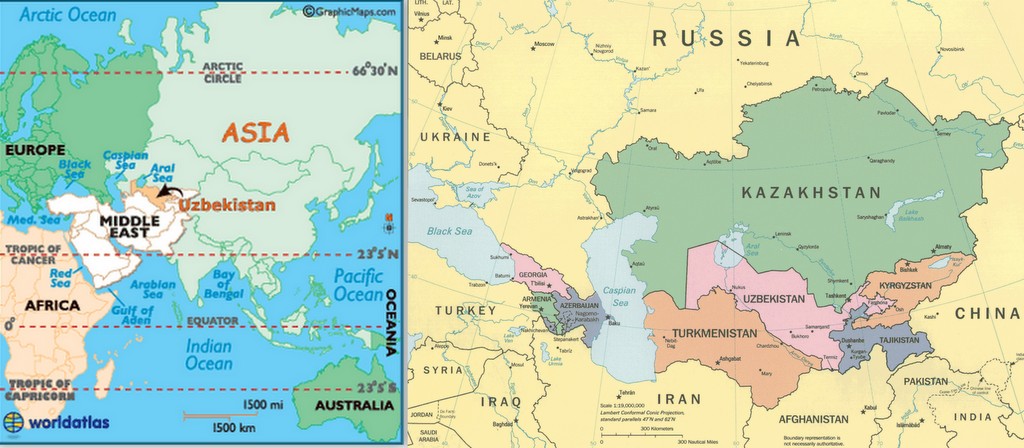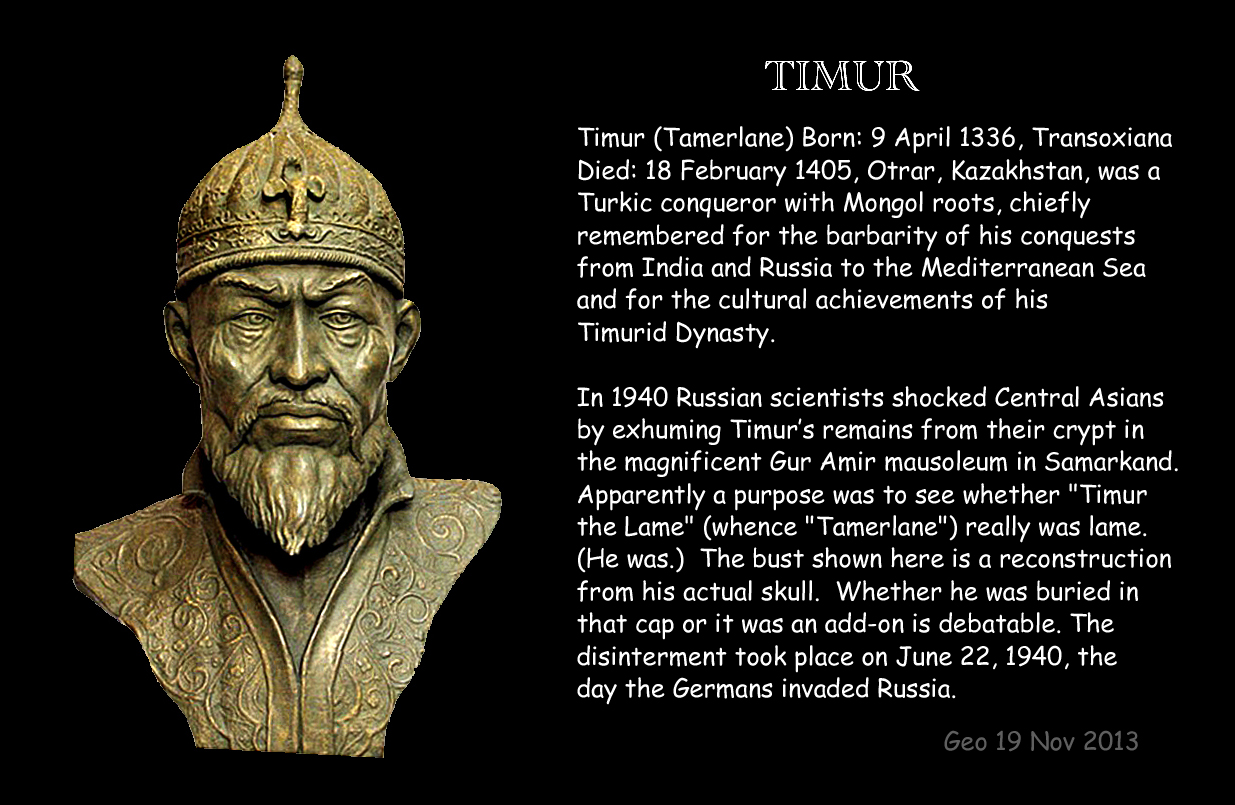
 |
|
Uzbekistan April-May, 2015
One of the “Stans” of Central Asia This trip preceded my Wild West Mongolia tour. Uzbekistan wasn’t exactly on the way to Mongolia; nor particularly relevant to it. Except that it lies on the Great Eurasian Steppe, as does Mongolia; and experienced the fury of the Mongol hordes. Oh, and its people originated from the Turkic people that occupied the steppes of today’s Mongolia long before the Mongols. So, I guess there’s a deal of relevance. Uzbekistan, as such, is a more recent political invention created by Stalin – along with other “Stans” that were in the former Soviet Union – in a way that divided clan allegiances and trampled on their “glory days.” As you can see from the map below, Uzbekistan is part of Central Asia and is surrounded by its former fellow Soviet Republics, now all independent nations: Kazakhstan, Kyrgyzstan, Tajikistan and Turkmenistan, with a southern border joining Afghanistan.
Its main attraction today is its history: the role of Samarkand, Bukhara and Khiva as destinations and staging points on the ancient Silk Road; the glorious past of the Khorezm Kingdom; and the conquests and structures of the Timurid Empire of Tamerlane (Timur). Tashkent The start and finish point was Tashkent, the capital of Uzbekistan.
The modern part of town has the obligatory city square, where, following independence from the toppled Soviet Union, the Turkic (Uzbek for current purposes) conqueror, Tamerlane, has replaced Lenin. Neither would seem to represent any unifying or even generally accepted national identity. The War Memorial was impressive (Uzbekistan having lost several hundred thousand in the WW II). The inscription reads (literal translation): “You will forever be in our hearts, beloved patriot”. I guess it’s our version of Lest we Forget.
Korezm
Their location on the desert stretching east from the Oxus River (so named by Alexander the Great) – now called the Amur Darya – pretty much takes them off the popular tourist paths. Finding some of them was a problem even for our local driver.
There’s reputed to be over fifty of them spread across the edges of the Kyzylkum Desert, but we had time to visit only four, three of which were truly spectacular.
Arriving in Khiva late in the day gave us two nights and a full day sightseeing there. Khiva is in north Uzbekistan. We’re still in Karakalpakstan or the Khorezm of past days. While Khiva can trace its existence back some millennia, its main historical notoriety has been its demise and revival following the ravages of the Arab invasions, its complete destruction by Genghis Khan’s invasion, its subjugation by Tamerlane and its colonisation by the Russian tsars. Given its being razed to the ground by the Mongols and substantially ransacked by the Timurids (Tamerlane) and the Russians, it’s a wonder there is so much to be amazed by. Most of its attractions date from the 18th and 19th centuries. The city has been spectacularly reconstructed throughout both the Soviet and independent years. Some 20 madrassahs (what we might call seminaries) have been reborn as hotels, restaurants, galleries and artisans’ workshops and outlets. It has the nation’s tallest minaret, which we climbed!
From Khiva to Bukhara Today was a car trip to cover 450km from Khiva to Bukhara. Our journey would take us through the Kyzylkum Desert stretching across a large slab of Uzbekistan. Lots of sand – inevitably; and lots of low bushes – probably an equivalent of our Salt Bush which is prevalent along the Stuart Hwy through Outback South Australia. Some 90km or so was high standard dual carriageway, some built by Korea and some built by Germany. The rest was single lane with plentiful blemishes – not so much potholes as serious surface corruption; obliging traffic in both directions to wander all over the road in often futile attempts to find a smooth path. A bit disconcerting at times watching an over-laden truck coming along our side convinced that the grass was greener there. At times the Amur Darya River – named by Alex the Great as the Oxus, a name used for centuries and which became a long-term geographic and political boundary of kingdoms to follow – was not far off to our right (i.e. to the west). We were travelling in the land once known as Transoxiana – a land coveted over centuries by warring kingdoms. A land also traversed by the camel caravans of the Silk Road. It didn’t seem a land that was particularly hospitable to either. Bukhara
A 6-7km walking tour (next day!) took us to and through the mostly-restored mosques, madrassahs (religious schools), mausoleums and markets. As in Khiva, the madrassahs no longer have their original function (except of one in Bukhara); and have become outlets for artisans and sellers of all sorts of handicrafts. They make excellent venues for such, combining function with tourist attraction in themselves. Only a couple of the mosques were “operational”. Those that are not freely display their past and present grandeur. A lot of the market stalls were housed in an old domed structure originally designed for trading. The lay-out of Bukhara meant that the attractions in the Old City were within walking distance and located in ways that invited you back many times to take in their atmosphere and explore their magnetism. Being only two of us, we were able go inside the Great Emir’s Friday Mosque and enjoy its peaceful atmosphere – something most other tourists would not experience.
On our second day, apart from a visit to the small four-minareted madrassah of Chor-Minar, the tour was “out of town”. The sights would have been well out of town in their day, but are now within greater Bukhara. The first stop was at a complex built round the tomb of Bakhoutdin Naqshbandi, a renowned Muslim Sufi (equivalent to a saint in Christian concepts) that is regarded as so holy a site that three pilgrimages to it replaced the obligation to make a pilgrimage to Mecca.
Final stop was the huge Chor-Bakr Necropolis. The site is dominated by a huge mosque and cloister for Sufis surrounded by the tombs of a family who traced their ancestry to Mohammed himself. The vast array of tombs, most still in desperate need of restoration, belong to widely extended family members. For a late lunch we dropped into a small local café. The lady in charged first ushered us into the kitchen to see what was on offer and choose from the various pots bubbling on the stove. Novel menu! Wandering along the streets afterwards we were initially stopped from entering an obvious restoration site until a man came and invited us in to a marvellous spectacle of a much advanced restoration of an old bathhouse. This was all before our $3.50 dinner accompanied by a local red wine called “Bear’s Blood”! in to a marvellous spectacle of a much advanced restoration of an old bathhouse. This was all before our $3.50 dinner accompanied by a local red wine called “Bear’s Blood”! Bukhara to Samarkand Not so long a drive today. A car trip from Bukhara to Samarkand. But still six hours with a couple of stops along the way. First was the small town of Vabkent that hosts a minaret comparable to its sibling one in Bukhara. Several kilometres further was an interesting combination of iconic or archetypical structures from this part of the world: the caravanserai and the sardoba. The former was the often extensive structures that housed and provided protection to the caravans (camel and donkey trains) plying the old Silk Road. The latter was a dome shaped cistern that held and preserved fresh cool water to supply the caravanserai. Sardobas were more plentiful than caravanserais as they were built in many places to support villages and other settlements. Samarkand
It has a history going back a couple of thousand years BC. But that was centred on the ancient city of Marakanda the capital of Sogdiana (it all sounds like Game of Thrones), which welcomed Alexander the Great but was later conquered by him for its back-stabbing. Marakanda’s excavations are not far from the centre of today’s Samarkand. Centuries later Genghis Khan completely destroyed Samarkand. In the words of our guide, Samarkand was rebuilt by Tamerlane from the ashes of Genghis Khan’s destruction. Tamerlane (aka Timur or Timur the Lame) passed himself off (knowingly deceptively) as a descendent of GK and set up the extensive Timurid Empire with Samarkand as its capital.
Tamerlane’s mausoleum is a key shrine for pilgrims who pray at his cenotaph. His wife had her own highly regarded reputation leading to a mosque in her name – the Bibi-Khanum Mosque. Tamerlane’s grandson, Ulugh Beg, acquired a world-wide reputation for his advanced astronomy. Remains of his observatory were lost for centuries but later excavated. He also built one of the madrassahs in the Registan as a secular university – the first of its kind in Central Asia.
The complex housed the shrine to a close relative of Muhammad. Hence its sacred status. The complex included several impressive mausoleums of significant personalities associated with Tamerlane. Adjacent to the complex was a large cemetery noted for its Soviet era design of tombstones.
A treat to end the day was the two hour train ride to Tashkent on the “Afrosiab” – Uzbekistan’s Very Fast Train (it’s the Spanish version of the VFT). The display screen in the carriage hit 230kph a few times.
Here is the photo album of the tour.
Return to Top of Page Go to Non-MC Meanders |



